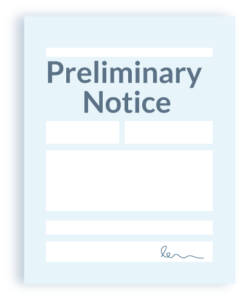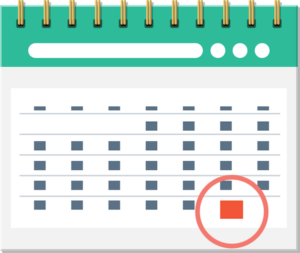
At the start of any construction project, it’s important to gather the tools you need. In this case, we’re talking about a preliminary notice — which in Arizona is also called a “preliminary 20-day lien notice,” “preliminary lien notice,” or simply, a “20-day notice.” In this article, we explain how to prepare and send an Arizona 20-day preliminary notice to secure your right to file a mechanics lien or bond claim.
What is an Arizona 20-Day Preliminary  Notice?
Notice?
An Arizona 20-Day preliminary notice is a legal document that contractors, suppliers, equipment lessors, and other vendors send on construction projects within the state. These notices help identify who is working on the project, what labor, materials, or services they are providing, who they were hired by, and the estimated value of their contributions.
The actual document itself is relatively simple and straightforward. You can find a free, downloadable preliminary notice form template here to get you started. Our forms are created and reviewed by construction attorneys to meet the Arizona statutory requirements.
Besides providing identifying information, the most important aspect of Arizona preliminary notices is that they are required to be served on certain parties in order to preserve that parties’ right to file a mechanics lien or bond claim on the project if they go unpaid.
Why to send an Arizona 20-Day Preliminary Notice
Sending preliminary notice helps establish a transparent payment chain and open lines of communication, all while keeping lien rights alive in case payment doesn’t happen as planned.
Not sending a preliminary notice will spoil your lien/bond claim rights
Sending preliminary notice is a requirement in Arizona. On private projects, sending preliminary notice protects and secures your right to file an Arizona mechanics lien. On public works projects, it can protect an Arizona subcontractor’s right to make a bond claim.
In either case, failure to send a preliminary notice on public and private construction projects in the state of Arizona, is fatal to lien and bond rights. Without which, the legal options to recover in case of non-payment will be severely limited.
Preliminary notices are for the owner and GC’s benefit
One of the main benefits of sending a preliminary notice is promoting visibility on the project. The contracting chain on any given construction project can get long, and complicated quickly. Sometimes, you won’t have contact, or even know who else is working on a project. By requiring preliminary notices, this protects the owner and GC from “surprise liens” being filed against the property. When a notice is sent, the higher-tiered project participants know who are, what you are contributing, and how to contact you if a problem arises.
Promotes good business relationships
Preliminary notices also support good working relationships. Property owners, lenders, and general contractors use notices to understand who is working on the job. This is especially beneficial on large projects.
Basically, a preliminary notice lets everyone on a construction project know that you are working on the project. It’s a good way to make sure that top-of-the-chain parties know everyone on the project. This can really be handy when working on a large scale project. Keeping everyone informed and on the same page on a construction project encourages cooperation and fair payment – and preliminary notices go a long way in this endeavor.
Preliminary notices can speed up payment
When you start a new construction project, you will obviously hope for the best. You expect the project to finish successfully. You expect to get paid. However, it is difficult to predict when payment problems will arise. And this is more difficult in recessions or other challenging economic environments. Sending preliminary notice protects your business against cash problems you can’t predict.
When the project stakeholders receive a preliminary notice, they understand that you are serious about getting paid. This understanding typically results in your invoices getting a higher priority status. The owner or general contractor will be sure that these invoices are paid promptly to avoid a lien filing.
When preliminary notices are required to retain the right to file a mechanics lien (as is the case in Arizona), and those notices aren’t sent, those parties are the ones that can be strung along a bit longer for payment if cash flow becomes an issue. And in construction, cash flow is almost always an issue.
Keep in mind:
- If you don’t send an Arizona preliminary notice…you can’t file a lien!
- It’s hard to predict payment problems…so make sure you’re prepared for them by sending a notice.
- Don’t be afraid of sending preliminary notices! Keeping everyone informed promotes cooperation and facilitates communication.
- In order to file a mechanics lien on an owner-occupied residence in Arizona, one must have a written contract with the property owner.
Who needs to send an Arizona preliminary notice? Who receives them?
In Arizona, everyone must send a preliminary 20-day notice to preserve the right to file a lien or bond claim for non-payment. The only exception to the notice requirement is for individual laborers – they do not need to send a pre lien notice. The notice requirement applies to both private and public construction projects. Although there are some subtle differences between the two. Which is why it’s important to know the type of project you’re working on.
Private projects: Who sends and who receives?
Private projects include any residential, commercial, industrial, or other type of construction project that isn’t commissioned or financed by a public or governmental entity.
The following parties must always send a 20-day preliminary notice:
- General contractors;
- Subcontractors;
- Material suppliers; &
- Equipment lessors.
The one major exception to this rule is laborers. Any potential lien claimant that performs only labor for hourly wages are exempt from this requirement. Many states exempt parties (like the general contractor) who contracts directly with the owner. Arizona does not. You must send a notice even if you contracted directly with the owner.
Claimants must send a 20-day preliminary notice to the following recipients:
- Construction lender (if any);
- Property owner;
- General contractor; &
- Hiring party (i.e. your customer).
Basically, most parties who are above you on the contracting chain need to receive a preliminary notice. For example, GC’s are only required to send notice to the owner and the lender (if there is one). If working as a sub-subcontractor, this list will also include the party who you contracted with. Additionally, if the project is a tenant improvement, the notice should be sent to them as well.
Public projects: Who sends and who receives?
Public projects include any construction contracted for by a state, county, municipal, or local governmental entity, and any other public entity or state university. The only exception here is federal projects; these are governed under the US Federal Miller Act. Which, for the record, doesn’t require preliminary notices.
On public projects, general contractors do not need to provide preliminary notice. Why, you ask? Because a mechanics lien claim isn’t available for public projects, instead unpaid contractors and suppliers will file a claim against the payment bond instead. Since the GC is the one posting the bond, they can’t make a claim against it.
Those required to send a preliminary notice on Arizona public projects include all participants that are second tier subcontractors and lower. Meaning anyone who didn’t contract direct with the general contractor. Although, it’s typically a best practice to do so. Suppliers are also required to send notice, regardless of who they contracted with. Lastly, the same hourly wage laborer is exempt from this notice requirement as well.
A 20-day preliminary notice on public projects need to be sent to:
- Public entity commissioning the work;
- General contractor; &
- Surety (if known).
What to include on the preliminary notice
An Arizona preliminary notice doesn’t need to be formatted in any particular way like lien claims do. However, it must contain all of the required information in order to be valid.
This includes all of the following:
- General description of the labor, professional services, materials, machinery, fixtures or tools furnished or to be furnished, and an estimate of the total price thereof;
- Name and address of the person giving notice;
- Name and address of the hiring party;
- Legal description of the property, subdivision plat, street address, location with respect to commonly known roads or other landmarks in the area, or any other description of the jobsite sufficient for identification
- Statutory notice language as required under Arizona Revised Statutes §33-992.01.
AZ’s 30% rule
There is one more important thing to note under the so-called “AZ 30% Rule.” The estimated total price of the labor and materials to be furnished, is just that. An estimate. However, as the project progresses, if the value of services being provided exceeds 30% of the initial total claimed in the preliminary notice, and amendment notice must be sent. This is essentially a 30% buffer for any additional work or change orders.
Inaccurate information
The notice language required in the Arizona Preliminary notice also covers this situation. The relevant part reads:
Within ten days of the receipt of this preliminary twenty day notice the owner or other interested party is required to furnish all information necessary to correct any inaccuracies in the notice pursuant to Arizona Revised Statutes section 33-992.01, subsection I or lose as a defense any inaccuracy of that information
Furthermore, if the claimant receives information showing that the preliminary notice is inaccurate in any way, the claimant must revise their preliminary notice within 30 days of obtaining said information. And it’s well established under Wang Electric, Inc. v. Smoke Tree Resort; that “if the claimant timely serves more than one preliminary notice naming a different owner or reputed owner, the subsequent lien will not extinguish the proper one.”
This also applies to bonded projects. If, after receipt of the 20-day notice, a payment bond is recorded, the owner must send a copy of the bond (including the name and address of the surety company and bonding information) within 10 days. Otherwise, the claimant will retain their lien rights, to the extent they are precluded or prejudiced from asserting a claim against the bond as a result of not timely receiving the bond information.

The #1 reason liens get rejected: Bad information.
Learn more about job research team. We'll track down and verify all of the job information you need to complete your form and file a valid mechanics lien.

When to send a 20-day notice
As you may have gleaned from the title of the notice, an Arizona 20-day preliminary notice needs to be sent within 20 days of first furnishing labor or materials to the project. Prudent construction companies will send this notice as soon as possible, on every project. As simple as this rule seems, there are some nuances that should be addressed.
Can you send notice early in Arizona?
There is nothing in the statute, or relevant case law, that suggest a notice can be sent too early. Only that it must be served within 20 days after first furnishing to secure your full lien or bond rights (more on that in the next section). However, there are some considerations that should be kept in mind when sending an early notice.
The best thing to do is to make a habit of sending a preliminary notice as soon as work commences. Hopefully, no claim will be necessary. Of course, it’s best to keep lien rights intact, just in case.
Can you send notice late in Arizona?
Here’s where “full lien protection” comes into play. Similar to California’s preliminary notice rules, an Arizona 20-day notice can be sent later than the initial 20 day period. However, the scope of lien protection will be limited. Once the notice is served, the claimant’s lien rights are only secured for the value of labor or materials provided in the preceding 20 days of the receipt of this preliminary notice; and everything thereafter.
For example, if you send a preliminary notice on Day 30, you cannot file a lien for any labor or materials provided on Days 1 through 10, but you are good to go from Day 11 to the end of the project. That’s good news for Arizona claimant considering late notice can be fatal in other states.
Arizona’s notice requirement is met when SENT, not delivered
As far as serving the notice on time, a common question is “when is the notice considered served? Upon mailing? Or upon receipt? This is a big concern for contractors, because, “What if the owner refuses to claim preliminary notice mailing in Arizona?“
Well the answer in Arizona, is that the notice is considered “served” when the notice is deposited in the mail by the proper means (more on that below). So the rule is that the notice must be sent within 20 days. This is true even if the notice isn’t actually received until past the 20-day deadline. In fact, the owner doesn’t even need to accept a preliminary notice in order for the courts to consider it valid.
But again, sending the notice as early as possible is always recommended. Don’t want until the last minute to send your Arizona 20-day preliminary notice.
Sending an amended notice
If the price increases during the project by more than 30%, you may need to send an additional preliminary notice that reflects the new price. Arizona wrote a law about this that went into effect on December 31, 2019.
- For projects that began before that date, the threshold for sending a new notice is 20%.
- For projects that began on or after 12/31/19, participants must send a new notice if the price increased by 30% or more.
Keep in mind:
- Best practice is to send a preliminary notice as soon as you commence work.
- Better late than never! It is much better to maintain lien rights for recent work than for no work at all.
- The preliminary notice must be sent within the 20-day notice period, and actual delivery is not required within the period. The requirement is considered met if properly sent within the period.
How to send a preliminary notice in Arizona?
An Arizona 20 Day Preliminary Notice must be delivered by registered or certified mail, and the sender must obtain a certificate of mailing, receipt of registration, or receipt of certification. Arizona law also requires proof that the notice was given. This means you need acknowledgment of receipt either by:
- Signature of the person receiving the notice, or
- Providing an “Affidavit of Proof of Service.”
Affidavits are generally used if the person to whom the notice was sent fails to complete an acknowledgment within 30 days. The affidavit should be accompanied by the certificate of mailing or by the receipt of certification or registration as proof that the notice was sent. That way you have some acknowledgement of receipt. Also, it’s a good idea to keep a copy of the preliminary notice for your records as well.
These mailing requirements apply to both private and public jobs. For more on this, see: Arizona Public Preliminary Notice Delivery Method Clarified.
Get preliminary notice help with Levelset
Thousands of Arizona-based construction companies utilize Levelset to better manage their payment process, send documents (especially 20-day notices), secure their lien rights, and especially, to get paid.
We have some additional resources and information available for your below. And if you have more questions or even if you don’t know where to turn, we’re always here to help.


 Notice?
Notice?


